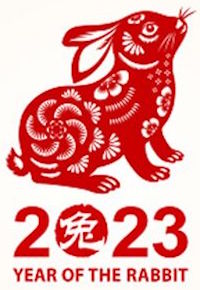Chinese New Year celebrations begin today (January 22) and end on February 5. It’s the beginning of the Year of the Rabbit and will last through February 9, 2024.

There’s no set date for Chinese New Year. Typically, Chinese New Year begins between late January and late February, timed to the new Moon. The holiday falls on different dates every year because it’s based on the ancient Chinese lunar calendar —that is based on lunar phases, solstices and equinoxes. Chinese New Year typically lasts around 15 or 16 days because it begins with the new Moon that falls sometime between the end of January and the end of February, and ends on the following full Moon.
If you’re in China, you’ll hear Chinese New Year referred to as “chunjie” or the Spring Festival. The Spring Festival was originally a ceremonial day to pray to the gods for a good planting and harvest season. As an agrarian society, the harvest was everything, but people also prayed to their ancestors, because they were treated as gods….
The Chinese have many myths for any subject or occasion — one concerning the new year goes that once there was a monster named Nian that would come around every New Year’s Eve. Most people hid in their homes, but one boy was brave enough to fight him off using firecrackers. The next day, people celebrated their survival by setting off even more firecrackers — that practice became a crucial part of Chinese New Year.
Even today, firecrackers are supposed to scare off monsters and bad luck. So people stay up on Chinese New Year’s Eve and set off firecrackers at midnight. In the morning, firecrackers are used again to welcome the new year and good luck.
Something that is synonymous with Chinese New Year is red envelopes. In almost every culture, children receive gifts for the holidays, and gifts are exchanged during the Spring Festival, but on Chinese New Year day, Chinese children receive red envelopes, that are sometimes called red packets or pockets — they contain money. This money is supposed to help transfer fortune from the elders to the kids. These envelopes may also be given between bosses and employees, co-workers or friends. I just read that with the development of technology, digital red envelopes are the trend now…oh, well.
Technically, during the Spring Festival, you eat dumplings for every meal. Actually, not many people do that anymore, so most people eat dumplings during the New Year’s Eve dinner. Dumplings aren’t that popular everywhere in China —they’re preferred mostly in northern China. In southern China, people prefer springs rolls and balls of glutinous rice in a soup called tangyuan.
There’s a Chinese saying that there’s no manners and/or etiquette without wine. This means that you need to have wine for every ceremony, festival or important dinner — naturally wine is a big part of New Years festivities. But when you’re eating with someone older than you, as is the case with New Year’s dinners, you need to follow strict toasting etiquette rules. They include the order of the toasts, seating, how you hold the wine glass, etc.
Chinese New Year is closely tied to religious practices and beliefs from Confucianism, Buddhism, Taoism and various ancient folk religions, but today it is mostly celebrated as a secular holiday in China.
The new year greeting in Chinese is “xin nian kuai le” — the phrase literally means “Happy New Year.” In Mandarin Chinese, the phrase is “gong xi fa cai” that means “congratulation on the fortune.”
So as we say goodbye to the Year of the Tiger and welcome the Year of the Rabbit, I wish you peace, love and prosperity. Gong xi fa kai!
— 30 —
